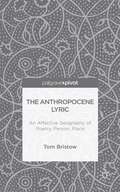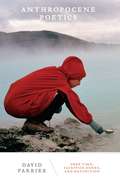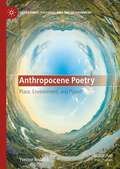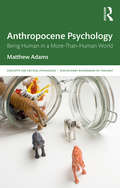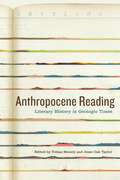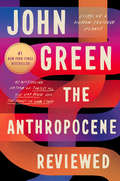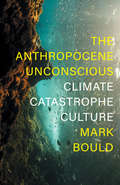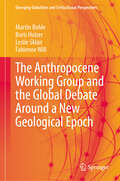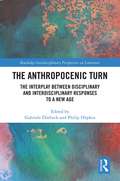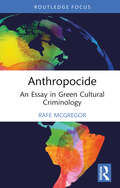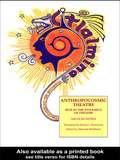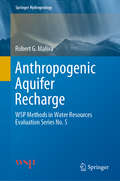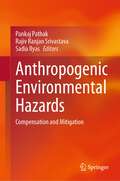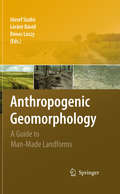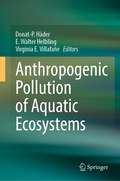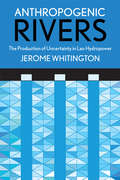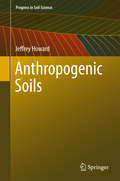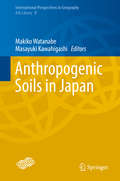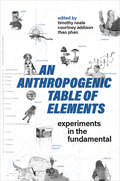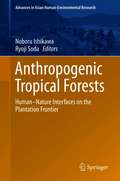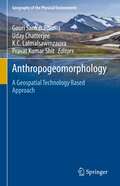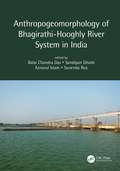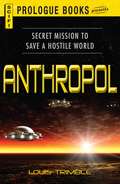- Table View
- List View
The Anthropocene Lyric: An Affective Geography of Poetry, Person, Place
by Tom BristowThis book takes the work of three contemporary poets-John Burnside, John Kinsella and Alice Oswald-to reveal how an environmental poetics of place is of significant relevance for the Anthropocene: a geological marker asking us to think radically of the human as one part of the more-than-human world.
Anthropocene Poetics: Deep Time, Sacrifice Zones, and Extinction (Posthumanities #50)
by David FarrierHow poetry can help us think about and live in the Anthropocene by reframing our intimate relationship with geological time The Anthropocene describes how humanity has radically intruded into deep time, the vast timescales that shape the Earth system and all life-forms that it supports. The challenge it poses—how to live in our present moment alongside deep pasts and futures—brings into sharp focus the importance of grasping the nature of our intimate relationship with geological time. In Anthropocene Poetics, David Farrier shows how contemporary poetry by Elizabeth Bishop, Seamus Heaney, Evelyn Reilly, and Christian Bök, among others, provides us with frameworks for thinking about this uncanny sense of time.Looking at a diverse array of lyric and avant-garde poetry from three interrelated perspectives—the Anthropocene and the &“material turn&” in environmental philosophy; the Plantationocene and the role of global capitalism in environmental crisis; and the emergence of multispecies ethics and extinction studies—Farrier rethinks the environmental humanities from a literary critical perspective. Anthropocene Poetics puts a concern with deep time at the center, defining a new poetics for thinking through humanity&’s role as geological agents, the devastation caused by resource extraction, and the looming extinction crisis.
Anthropocene Poetry: Place, Environment, and Planet (Literatures, Cultures, and the Environment)
by Yvonne ReddickAnthropocene Poetry: Place, Environment and Planet argues that the idea of the Anthropocene is inspiring new possibilities for poetry. It can also change the way we read and interpret poems. If environmental poetry was once viewed as linked to place, this book shows how poets are now grappling with environmental issues from the local to the planetary: climate change and the extinction crisis, nuclear weapons and waste, plastic pollution and the petroleum industry. This book intervenes in debates about culture and science, traditional poetic form and experimental ecopoetics, to show how poets are collaborating with environmental scientists and joining environmental activist movements to respond to this time of crisis. From the canonical work of Ted Hughes and Seamus Heaney, to award-winning poets Alice Oswald, Pascale Petit, Kei Miller, and Karen McCarthy Woolf, this book explores major figures from the past alongside acclaimed contemporary voices. It reveals Seamus Heaney’s support for conservation causes and Ted Hughes’s astonishingly forward-thinking research on climate change; it discusses how Pascale Petit has given poetry to Extinction Rebellion and how Karen McCarthy Woolf set sail with scientists to write about plastic pollution. This book deploys research on five poetry archives in the UK, USA and Ireland, and the author’s insider insights into the commissioning processes and collaborative methods that shaped important contemporary poetry publications. Anthropocene Poetry finds that environmental poetry is flourishing in the face of ecological devastation. Such poetry speaks of the anxieties and dilemmas of our age, and searches for paths towards resilience and resistance.
Anthropocene Psychology: Being Human in a More-than-Human World (Concepts for Critical Psychology)
by Matthew AdamsThis ground-breaking book critically extends the psychological project, seeking to investigate the relations between human and more-than-human worlds against the backdrop of the Anthropocene by emphasising the significance of encounter, interaction and relationships. Interdisciplinary environmental theorist Matthew Adams draws inspiration from a wealth of ideas emerging in human–animal studies, anthrozoology, multi-species ethnography and posthumanism, offering a framing of collective anthropogenic ecological crises to provocatively argue that the Anthropocene is also an invitation – to become conscious of the ways in which human and nonhuman are inextricably connected. Through a series of strange encounters between human and nonhuman worlds, Adams argues for the importance of cultivating attentiveness to the specific and situated ways in which the fates of multiple species are bound together in the Anthropocene. Throughout the book this argument is put into practice, incorporating everything from Pavlov’s dogs, broiler chickens, urban trees, grazing sheep and beached whales, to argue that the Anthropocene can be good to think with, conducive to a seeing ourselves and our place in the world with a renewed sense of connection, responsibility and love. Building on developments in feminist and social theory, anthropology, ecopsychology, environmental psychology, (post)humanities, psychoanalysis and phenomenology, this is fascinating reading for academics and students in the field of critical psychology, environmental psychology, and human–animal studies.
Anthropocene Reading: Literary History in Geologic Times (AnthropoScene: The SLSA Book Series #1)
by Tobias Menely Jesse Oak TaylorFew terms have garnered more attention recently in the sciences, humanities, and public sphere than the Anthropocene, the proposed epoch in which a human “signature” appears in the lithostratigraphic record. Anthropocene Reading considers the implications of this concept for literary history and critical method.Entering into conversation with geologists and geographers, this volume reinterprets the cultural past in relation to the anthropogenic transformation of the Earth system while showcasing how literary analysis may help us conceptualize this geohistorical event. The contributors examine how a range of literary texts, from The Tempest to contemporary dystopian novels to the poetry of Emily Dickinson, mediate the convergence of the social institutions, energy regimes, and planetary systems that support the reproduction of life. They explore the long-standing dialogue between imaginative literature and the earth sciences and show how scientists, novelists, and poets represent intersections of geological and human timescales, the deep past and a posthuman future, political exigency and the carbon cycle.Accessibly written and representing a range of methodological perspectives, the essays in this volume consider what it means to read literary history in the Anthropocene.Contributors include Juliana Chow, Jeffrey Jerome Cohen, Thomas H. Ford, Anne-Lise François, Noah Heringman, Matt Hooley, Stephanie LeMenager, Dana Luciano, Steve Mentz, Benjamin Morgan, Justin Neuman, Jennifer Wenzel, and Derek Woods.
Anthropocene Reading: Literary History in Geologic Times (AnthropoScene)
by Steve Mentz Dana Luciano Jeffrey Jerome Cohen Jennifer Wenzel Benjamin Morgan Thomas H. Ford Stephanie LeMenager Justin Neuman Juliana Chow Noah Heringman Matt Hooley Derek Woods Anne-Lise FrançoisFew terms have garnered more attention recently in the sciences, humanities, and public sphere than the Anthropocene, the proposed epoch in which a human “signature” appears in the lithostratigraphic record. Anthropocene Reading considers the implications of this concept for literary history and critical method.Entering into conversation with geologists and geographers, this volume reinterprets the cultural past in relation to the anthropogenic transformation of the Earth system while showcasing how literary analysis may help us conceptualize this geohistorical event. The contributors examine how a range of literary texts, from The Tempest to contemporary dystopian novels to the poetry of Emily Dickinson, mediate the convergence of the social institutions, energy regimes, and planetary systems that support the reproduction of life. They explore the long-standing dialogue between imaginative literature and the earth sciences and show how scientists, novelists, and poets represent intersections of geological and human timescales, the deep past and a posthuman future, political exigency and the carbon cycle.Accessibly written and representing a range of methodological perspectives, the essays in this volume consider what it means to read literary history in the Anthropocene.Contributors include Juliana Chow, Jeffrey Jerome Cohen, Thomas H. Ford, Anne-Lise François, Noah Heringman, Matt Hooley, Stephanie LeMenager, Dana Luciano, Steve Mentz, Benjamin Morgan, Justin Neuman, Jennifer Wenzel, and Derek Woods.
The Anthropocene Reviewed: Essays on a Human-Centered Planet
by John GreenA deeply moving and insightful collection of personal essays from #1 bestselling author John Green. <p><p>The Anthropocene is the current geologic age, in which humans have profoundly reshaped the planet and its biodiversity. In this remarkable symphony of essays adapted and expanded from his groundbreaking podcast, bestselling author John Green reviews different facets of the human-centered planet on a five-star scale—from the QWERTY keyboard and sunsets to Canada geese and Penguins of Madagascar. Funny, complex, and rich with detail, the reviews chart the contradictions of contemporary humanity. As a species, we are both far too powerful and not nearly powerful enough, a paradox that came into sharp focus as we faced a global pandemic that both separated us and bound us together. <p><p>John Green’s gift for storytelling shines throughout this masterful collection. The Anthropocene Reviewed is a open-hearted exploration of the paths we forge and an unironic celebration of falling in love with the world. <p> <b>New York Times Bestseller</b>
The Anthropocene Unconscious: Climate Catastrophe Culture
by Mark BouldFrom Ducks, Newburyport to zombie movies and the Fast and Furious franchise, how climate anxiety permeates our cultureThe art and literature of our time is pregnant with catastrophe, with weather and water, wildness and weirdness. The Anthropocene - the term given to this geological epoch in which humans, anthropos, are wreaking havoc on the earth - is to be found bubbling away everywhere in contemporary cultural production. Typically, discussions of how culture registers, figures and mediates climate change focus on 'climate fiction' or 'cli-fi', but The Anthropocene Unconscious is more interested in how the Anthropocene and especially anthropogenic climate destabilisation manifests in texts that are not overtly about climate change - that is, unconsciously. The Anthropocene, Mark Bould argues, constitutes the unconscious of 'the art and literature of our time'.Tracing the outlines of the Anthropocene unconscious in a range of film, television and literature - across a range of genres and with utter disregard for high-low culture distinctions - this playful and riveting book draws out some of the things that are repressed and obscured by the term 'the Anthropocene', including capital, class, imperialism, inequality, alienation, violence, commodification, patriarchy and racial formations. The Anthropocene Unconscious is about a kind of rewriting. It asks: what happens when we stop assuming that the text is not about the anthropogenic biosphere crises engulfing us? What if all the stories we tell are stories about the Anthropocene? About climate change?
The Anthropocene Working Group and the Global Debate Around a New Geological Epoch (Emerging Globalities and Civilizational Perspectives)
by Martin Bohle Boris Holzer Leslie Sklair Fabienne WillThis book examines the role of the Anthropocene Working Group (AWG) in public and scholarly discussions of the meaning of the Anthropocene proposal. The status of the Anthropocene, both as a geoscientific concept and as a cultural concept becoming increasingly familiar in the public sphere, has been highly controversial. While geoscientists focus on possible geological markers and periodisation, the social sciences, environmental humanities, and creative arts have taken up the Anthropocene as a cultural concept to make sense of the planetary environmental crisis and contemporary society. This book documents intra-, inter-, and transdisciplinary debates, particularly, although not limited to, how different scholarly disciplines have responded to the Anthropocene proposal. The authors analyse how the AWG has become the focal point of a debate that straddles the boundaries between academic disciplines and public perceptions of science. The AWG thus serves as a case of the globalisation of science in terms of the global interconnectedness of scientific disciplines and the cultural significance of the Anthropocene proposal.
The Anthropocenic Turn: The Interplay between Disciplinary and Interdisciplinary Responses to a New Age (Routledge Interdisciplinary Perspectives on Literature)
by Gabriele Dürbeck Philip HüpkesThis interdisciplinary volume discusses whether the increasing salience of the Anthropocene concept in the humanities and the social sciences constitutes an "Anthropocenic turn." The Anthropocene discourse creates novel conceptual configurations and enables scholars to re-negotiate and re-contextualize long-established paradigms, premises, theories and methodologies. These innovative constellations stimulate fresh research in many areas of thought and practice. The contributors to this volume respond to the proposition of an "Anthropocene turn" from the perspective of diverse research fields, including history of science, philosophy, environmental humanities and political science as well as literary, art and media studies. Altogether, the collection reveals to which extent the Anthropocene concept challenges deep-seated assumptions across disciplines. It invites readers to explore the wealth of scholarly perspectives on the Anthropocene as well as unexpected inter- and transdisciplinary connections.
Anthropocide: An Essay in Green Cultural Criminology (Routledge Studies in Crime, Culture and Media)
by Rafe McGregorThrough an examination of Alfonso Cuarón’s Children of Men, this book demonstrates the ability of cinematic fictions, and other complex narrative fictions, to contribute to meeting the climate challenge by shaping the desires of audiences. What if there was a single feature film that showed us everything we need to know about climate catastrophe culture? What if that same film also made the philosophies of Slavoj Žižek, Mark Fisher, Francis Fukuyama, and Fredric Jameson accessible? Identifying the climate challenge as a cultural challenge, this book provides an unprecedented criminological analysis of both Children of Men and Fisher’s oeuvre from 1998 to 2022 and demonstrates the capacity of cinematic narratives to shape climate catastrophe culture. Seeking to be part of the solution to the climate challenge, it is the first criminological study to link the capacity of cinematic fictions to shape desire to solutions to the climate crisis. It is also one of the most detailed and most rigorous criminological case studies of a cinematic work to date.Anthropocide: An Essay in Green Cultural Criminology will be of great interest to students and scholars of green criminology, cultural criminology, narrative criminology, film theory, philosophy of film, and ecocriticism.
Anthropocosmic Theatre: Rite in the Dynamics of Theatre (Contemporary Theatre Studies #Vol. 13.)
by Nichos NunezFirst published in 1997. Routledge is an imprint of Taylor & Francis, an informa company.
Anthropogenic Aquifer Recharge: WSP Methods in Water Resources Evaluation Series No. 5 (Springer Hydrogeology)
by Robert G. MalivaThe book is an overview of the diversity of anthropogenic aquifer recharge (AAR) techniques that use aquifers to store and treat water. It focusses on the processes and the hydrogeological and geochemical factors that affect their performance. This book is written from an applied perspective with a focus of taking advantage of global historical experiences, both positive and negative, as a guide to future implementation. Most AAR techniques are now mature technologies in that they have been employed for some time, their scientific background is well understood, and their initial operational challenges and associated solutions have been identified. However, opportunities exist for improved implementation and some recently employed and potential future innovations are presented. AAR which includes managed aquifer recharge (MAR) is a very important area of water resources management and there is no recent books that specifically and comprehensively addresses the subject.
Anthropogenic Environmental Hazards: Compensation and Mitigation
by Pankaj Pathak Rajiv Ranjan Srivastava Sadia IlyasThis book delves into the anthropogenic activities responsible for environmental hazards, their compensation, and potential mitigation strategies. It sheds light on the major contributors to the climate change issues aggravated by non-sustainable practices for the overexploitation of natural resources. Critical topics such as high emissions in primary mining, the recovery of energy-critical metals by urban mining, solid waste management, and forest conservation are explored, offering insights into the urgent challenges we face.Amidst the rapid demand for resources and the expansion of human habitats, the book emphasizes the need for new approaches to natural resource management and introspection of our actions. Experts in the field discuss existing anthropogenic environmental hazards in detail, alongside environmental compensation, and effective mitigation approaches.The book begins with a chapter dedicated to risk assessment in primary mining activities for precious metals, proposing potential routes for mitigation. Chapter 2 focuses on assessing and mitigating the environmental footprints of energy-critical metals used in permanent magnets. In Chapter 3, a case study examines sustainable resource utilization through end-of-life room air conditioner recycling. Additional chapters provide critical insights into:The environmental impacts of e-waste and government policies for responsible managementHazards associated with industrial effluents and corresponding mitigation strategiesThe role of roadside plants in phytoremediation of heavy metal pollutionSustainable utilization of anthropogenic coal fly ash through mechanical and chemical activationEnvironmental damages resulting from the mismanagement of municipal solid wasteEnvironmental problems and remediation strategies for anthropogenic biomass wasteChallenges in sustainable municipal solid waste management and suggestions for environmental risk mitigation The book concludes with a chapter discussing collaborative governance and non-monetary compensation mechanisms for sustainable forest management. Given its breadth, this book serves as an indispensable resource for researchers, policymakers, and environmental professionals seeking sustainable approaches to tackle pressing environmental challenges.
Anthropogenic Geomorphology: A Guide to Man-Made Landforms
by Denes Loczy József Szabó Lóránt DávidAnthropogenic geomorphology studies society's impact on the geographical environment, and especially on the Earth's surface. This volume provides guidance to students discussing the basic topics of anthropogenic geomorphology. The chapters cover both its system, and its connections with other sciences, as well as the way the subject can contribute to tackling today's practical problems. The book represents all fields of geomorphology, giving an introduction to the diversity of the discipline through examples taken from a range of contexts and periods, and focusing on examples from Europe. It is no accident that anthropogenic geomorphology has been gaining ground within geomorphology itself. Its results advance not only the theoretical development of the science but can be applied directly to social and economic issues. Worldwide, anthropogenic geomorphology is an integral and expanding part of earth sciences curricula in higher education, making this a timely and relevant text.
Anthropogenic Pollution of Aquatic Ecosystems
by Donat-P. Häder E. Walter Helbling Virginia E. VillafañeThis book provides examples of pollutants, such as accidental oil spills and non-degradable plastic debris, which affect marine organisms of all taxa. Terrestrial runoff washes large amounts of dissolved organic materials from agriculture and industry, toxic heavy metals, pharmaceuticals, and persistent organic pollutants which end up into rivers, coastal habitats, and open waters. While this book is not intended to encyclopaedically list all kinds of pollution, it rather exemplifies the problems by concentrating on a number of serious and prominent recent developments. The chapters in this book also discuss measures to decrease and remove aquatic pollution to mitigate the stress on aquatic organisms. Aquatic ecosystems provide a wide range of ecological and economical services. In addition to providing a large share of the staple diet for a fast growing human population, oceans absorb most of the anthropogenically emitted carbon dioxide and mitigate climate change. As well as rising temperatures and ocean acidification, pollution poses increasing problems for aquatic ecosystems and organisms reducing its functioning and services which are exposed to a plethora of stress factors.
Anthropogenic Rivers: The Production of Uncertainty in Lao Hydropower (Expertise: Cultures and Technologies of Knowledge)
by Jerome WhitingtonIn the 2000s, Laos was treated as a model country for the efficacy of privatized, "sustainable" hydropower projects as viable options for World Bank-led development. By viewing hydropower as a process that creates ecologically uncertain environments, Jerome Whitington reveals how new forms of managerial care have emerged in the context of a privatized dam project successfully targeted by transnational activists. Based on ethnographic work inside the hydropower company, as well as with Laotians affected by the dam, he investigates how managers, technicians and consultants grapple with unfamiliar environmental obligations through new infrastructural configurations, locally-inscribed ethical practices, and forms of flexible experimentation informed by American management theory.Far from the authoritative expertise that characterized classical modernist hydropower, sustainable development in Laos has been characterized by a shift from the risk politics of the 1990s to an ontological politics in which the institutional conditions of infrastructure investment are pervasively undermined by sophisticated ‘hactivism.’ Whitington demonstrates how late industrial environments are infused with uncertainty inherent in the anthropogenic ecologies themselves. Whereas ‘anthropogenic’ usually describes human-induced environmental change, it can also show how new capacities for being human are generated when people live in ecologies shot through with uncertainty. Implementing what Foucault called a "historical ontology of ourselves," Anthropogenic Rivers formulates a new materialist critique of the dirty ecologies of late industrialism by pinpointing the opportunistic, ambitious and speculative ontology of capitalist natures.
Anthropogenic Soils (Progress in Soil Science)
by Jeffrey HowardThis book is a state-of-the-art review of the physical, chemical and mineralogical properties of anthropogenic soils, their genesis morphology and classification, geocultural setting, and strategies for reclamation, revitalization, use and management.
Anthropogenic Soils in Japan (International Perspectives In Geography Ser. #9)
by Masayuki Kawahigashi Makiko WatanabeThis book enhances the discussion of anthropized soils with photographs of soil profiles and provides general information about soils in Japan, using data on their physical and chemical properties. Soils targeted in this book have wide spectra in anthropized influences from lesser effects such as agricultural improvements to drastic changes caused by infrastructure construction. These include soils sealed by technic hard materials, on ski slopes, on river embankments and coastal berms, in historical urban parks, on man-made islands in Tokyo Bay, in reclaimed lands, in greenhouse fields, and those filling in swamplands. These examples supported with data can be a bridge between agriculture and civil engineering to understand how anthropogenic activities influence soils. Because anthropogenic impacts have increased during the past decades along with concentrations of populations into cities, processes in soils must be addressed from the point of view of diverse land-use purposes. The book includes information with new data produced by active researchers from many institutes and universities as it refers to soils altered by human activities and thus is informative to specialists in various disciplines related to soils. It is also valuable to students for viewing soils in cities, infrastructure construction areas, and other affected locations. Evaluation and understanding of soils now has become essential for researchers in a range of fields and for policy makers in agriculture as well as urban planning, civil engineering, and disaster sciences. This work serves as an impetus for launching further study of soils and environments.
An Anthropogenic Table of Elements: Experiments in the Fundamental (Technoscience and Society)
by Timothy Neale Courtney Addison Thao PhanAn Anthropogenic Table of Elements provides a contemporary rethinking of Dmitri Mendeleev’s periodic table of elements, bringing together "elemental" stories to reflect on everyday life in the Anthropocene. Concise and engaging, this book provides stories of scale, toxicity, and temporality that extrapolate on ideas surrounding ethics, politics, and materiality that are fundamental to this contemporary moment. Examining elemental objects and forces, including carbon, mould, cheese, ice, and viruses, the contributors question what elemental forms are still waiting to emerge and what political possibilities of justice and environmental reparation they might usher into the world. Bringing together anthropologists, historians, and media studies scholars, this book tests a range of possible ways to tabulate and narrate the elemental as a way to bring into view fresh discussion on material constitutions and, thereby, new ethical stances, responsibilities, and power relations. In doing so, An Anthropogenic Table of Elements demonstrates through elementality that even the smallest and humblest stories are capable of powerful effects and vast journeys across time and space.
Anthropogenic Tropical Forests: Human–Nature Interfaces on the Plantation Frontier (Advances in Asian Human-Environmental Research)
by Noboru Ishikawa Ryoji SodaThe studies in this volume provide an ethnography of a plantation frontier in central Sarawak, Malaysian Borneo. Drawing on the expertise of both natural scientists and social scientists, the key focus is the process of commodification of nature that has turned the local landscape into anthropogenic tropical forests. Analysing the transformation of the space of mixed landscapes and multiethnic communities—driven by trade in forest products, logging and the cultivation of oil palm—the contributors explore the changing nature of the environment, multispecies interactions, and the metabolism between capitalism and nature. The project involved the collaboration of researchers specialising in anthropology, geography, Southeast Asian history, global history, area studies, political ecology, environmental economics, plant ecology, animal ecology, forest ecology, hydrology, ichthyology, geomorphology and life-cycle assessment.Collectively, the transdisciplinary research addresses a number of vital questions. How are material cycles and food webs altered as a result of large-scale land-use change? How have new commodity chains emerged while older ones have disappeared? What changes are associated with such shifts? What are the relationships among these three elements—commodity chains, material cycles and food webs? Attempts to answer these questions led the team to go beyond the dichotomy of society and nature as well as human and non-human. Rather, the research highlights complex relational entanglements of the two worlds, abruptly and forcibly connected by human-induced changes in an emergent and compelling resource frontier in maritime Southeast Asia.
Anthropogeomorphology: A Geospatial Technology Based Approach (Geography of the Physical Environment)
by Gouri Sankar Bhunia Pravat Kumar Shit Uday Chatterjee K. C. LalmalsawmzauvaThis book explores state-of-art techniques based on open-source software and statistical programming and modelling in modern geospatial applications, specifically focusing on recent trends in data mining techniques and robust modelling in Geomorphological, Hydrological, Bio-physical and Social activities. The book is organized into physical, mountainous, coastal, riverine, forest, urban and biological activities, with each chapter providing a review of the current knowledge in the focus area, and evaluating where future efforts should be directed. The text compiles a collection of recent developments and rigorous applications of Geospatial computational intelligence (e.g., artificial neural network, spatial interpolation, physical and environmental modelling and machine learning algorithms etc) in geomorphic processes from a team of expert contributors. The authors address the wide range of challenges and uncertainties in the study of earth system dynamics due to climate change, and complex anthropogenic interferences where spatial modelling may be applied in the risk assessment of vulnerable geomorphological landscapes. The book will act as a guide to find recent advancements in geospatial artificial intelligence techniques and its application to natural and social hazards. This information will be helpful for students, researchers, policy makers, environmentalists, planners involved in natural hazard and disaster management, NGOs, and government organizations.
Anthropogeomorphology of Bhagirathi-Hooghly River System in India
by Balai Chandra DasThe Bhagirathi-Hooghly Basin in India is one of the most densely populated regions in the world and is undergoing rapid transformation of its natural landscape induced by human interventions, such as mushrooming of dams and barrages, deforestation, and urbanization. Human activities and interventions on basin landforms and the processes that shape those landforms have accelerated at an alarming rate. This book uses spatio-temporal analysis to understand the major anthropogenic signatures on land use and land cover changes and the impact these activities have on the landforms and processes of the Bhagirathi-Hooghly River and its sub-basins. It answers the what, where, why, and how of the anthropogenic signatures involved. Recent case studies on the impact of anthropogenic signatures on fluvial forms and processes make this book a useful resource for students and researchers in the earth sciences, local governments, urban planners, and all concerned with rural developments. Features: Explores for the first time the new concept of anthropogeomorphology for the river basin—an emerging field Analyses the impact of anthropogenic activities, especially the construction of dams and reservoirs, and urbanization on major fluvial landscapes using advanced geospatial modelling techniques Investigates human interference in river systems, their effects on the dynamics of the river, and the livelihoods of the people residing along the river Addresses issues related to geology, geomorphology, geography, planning, land use, and land management areas Fills the need for data-driven governance and policy decisions for the future of urban-industrial growth in India.
Anthropol
by Louis TrimbleIt's an urgent assignment for Vernay?get control of the totalitarian government of Ujvila. Hard enough, but Vernay's also got to do it before Galactic-Military solves the problem its own way: by slamming in an invasion force and destroying half the planet.The natives of Anthropol don't like aliens and they don't want Vernay. So it's going to be a tough assignment.One of the toughest of his career.
Anthropol
by Louis TrimbleIt’s an urgent assignment for Vernay?get control of the totalitarian government of Ujvila. Hard enough, but Vernay’s also got to do it before Galactic-Military solves the problem its own way: by slamming in an invasion force and destroying half the planet.The natives of Anthropol don’t like aliens and they don’t want Vernay. So it’s going to be a tough assignment.One of the toughest of his career.
